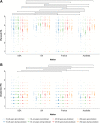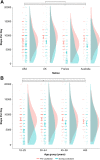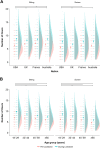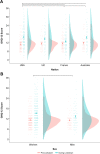Physical activity and mental well-being under COVID-19 lockdown: a cross-sectional multination study
- PMID: 34039306
- PMCID: PMC8154111
- DOI: 10.1186/s12889-021-10931-5
Physical activity and mental well-being under COVID-19 lockdown: a cross-sectional multination study
Abstract
Background: COVID-19 lockdowns have reduced opportunities for physical activity (PA) and encouraged more sedentary lifestyles. A concomitant of sedentariness is compromised mental health. We investigated the effects of COVID-19 lockdown on PA, sedentary behavior, and mental health across four Western nations (USA, UK, France, and Australia).
Methods: An online survey was administered in the second quarter of 2020 (N = 2541). We measured planned and unplanned dimensions of PA using the Brunel Lifestyle Physical Activity Questionnaire and mental health using the 12-item General Health Questionnaire. Steps per day were recorded only from participants who used an electronic device for this purpose, and sedentary behavior was reported in hours per day (sitting and screen time).
Results: In the USA and Australia samples, there was a significant decline in planned PA from pre- to during lockdown. Among young adults, Australians exhibited the lowest planned PA scores, while in middle-aged groups, the UK recorded the highest. Young adults exhibited the largest reduction in unplanned PA. Across nations, there was a reduction of ~ 2000 steps per day. Large increases in sedentary behavior emerged during lockdown, which were most acute in young adults. Lockdown was associated with a decline in mental health that was more pronounced in women.
Conclusions: The findings illustrate the deleterious effects of lockdown on PA, sedentary behavior, and mental health across four Western nations. Australian young and lower middle-aged adults appeared to fare particularly badly in terms of planned PA. The reduction in steps per day is equivalent to the non-expenditure of ~ 100 kcal. Declines in mental health show how harmful lockdowns can be for women in particular.
Keywords: Coronavirus; Exercise; International; Mental well-being; Pandemic.
Conflict of interest statement
The authors declare that they have no competing interests.
Figures




Similar articles
-
Relationships among behavioural regulations, physical activity, and mental health pre- and during COVID-19 UK lockdown.Psychol Sport Exerc. 2021 Jul;55:101945. doi: 10.1016/j.psychsport.2021.101945. Epub 2021 Apr 9. Psychol Sport Exerc. 2021. PMID: 34518758 Free PMC article.
-
Life in a time of COVID: retrospective examination of the association between physical activity and mental well-being in western Australians during and after lockdown.BMC Public Health. 2023 Apr 14;23(1):701. doi: 10.1186/s12889-023-15440-1. BMC Public Health. 2023. PMID: 37060048 Free PMC article.
-
Effects of the COVID-19 associated United Kingdom lockdown on physical activity in older adults at high risk of cardiovascular disease: a mixed methods perspective from the MedEx-UK multicenter trial.Front Public Health. 2024 May 9;12:1371453. doi: 10.3389/fpubh.2024.1371453. eCollection 2024. Front Public Health. 2024. PMID: 38784572 Free PMC article.
-
A scoping review on the impact of the COVID-19 pandemic on physical activity and sedentary behavior in Saudi Arabia.BMC Public Health. 2023 Mar 27;23(1):572. doi: 10.1186/s12889-023-15422-3. BMC Public Health. 2023. PMID: 36973687 Free PMC article.
-
Home-based exercise can be beneficial for counteracting sedentary behavior and physical inactivity during the COVID-19 pandemic in older adults.Postgrad Med. 2021 Jun;133(5):469-480. doi: 10.1080/00325481.2020.1860394. Epub 2020 Dec 30. Postgrad Med. 2021. PMID: 33275479 Review.
Cited by
-
Correlates of Changes in Physical Activity and Sedentary Behaviors during the COVID-19 Lockdown in France: The NutriNet-Santé Cohort Study.Int J Environ Res Public Health. 2022 Sep 28;19(19):12370. doi: 10.3390/ijerph191912370. Int J Environ Res Public Health. 2022. PMID: 36231670 Free PMC article.
-
Covid-19, pelvic health, and women's voices: A descriptive study.Continence (Amst). 2022 Mar;1:100012. doi: 10.1016/j.cont.2022.100012. Epub 2022 Mar 14. Continence (Amst). 2022. PMID: 35719421 Free PMC article.
-
Association between the Physical Activity Behavioral Profile and Sedentary Time with Subjective Well-Being and Mental Health in Chilean University Students during the COVID-19 Pandemic.Int J Environ Res Public Health. 2022 Feb 13;19(4):2107. doi: 10.3390/ijerph19042107. Int J Environ Res Public Health. 2022. PMID: 35206294 Free PMC article.
-
Changes in life satisfaction, depression, general health and sleep quality of Spanish older women during COVID-19 lockdown and their relationship with lifestyle: an observational follow-up study.BMJ Open. 2022 Aug 24;12(8):e061993. doi: 10.1136/bmjopen-2022-061993. BMJ Open. 2022. PMID: 36002204 Free PMC article.
-
Laboured reading and musculoskeletal pain in school children - the role of lifestyle behaviour and eye wear: a cross-sectional study.BMC Pediatr. 2022 Jul 13;22(1):416. doi: 10.1186/s12887-022-03465-1. BMC Pediatr. 2022. PMID: 35831809 Free PMC article.
References
-
- World Health Organization. Listings of WHO’s response to COVID-19. https://www.who.int/news-room/detail/29-06-2020-covidtimeline. Accessed 7 July 2020.
-
- Biswas A, Oh PI, Faulkner GE, Bajaj RR, Silver MA, Mitchell MS, et al. Sedentary time and its association with risk for disease incidence, mortality, and hospitalization in adults: a systematic review and meta-analysis. Ann Intern Med. 2015;162(2):123–32. 10.7326/M14-1651. - PubMed
MeSH terms
LinkOut - more resources
Full Text Sources
Other Literature Sources
Medical

